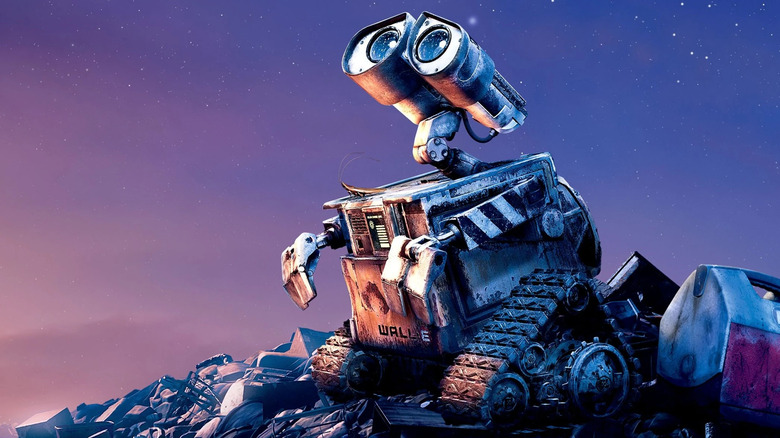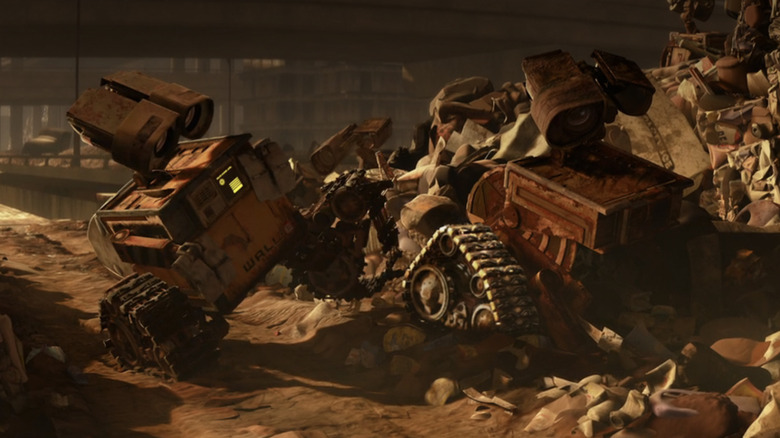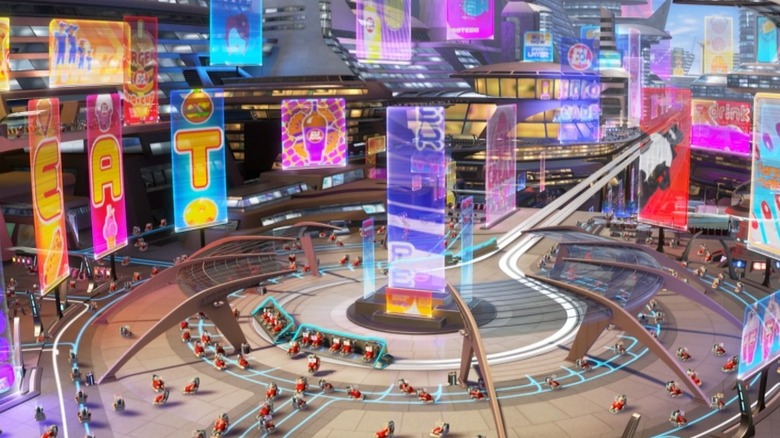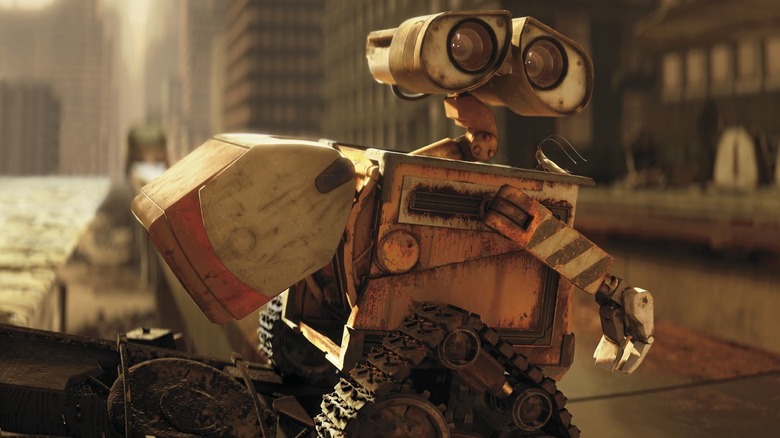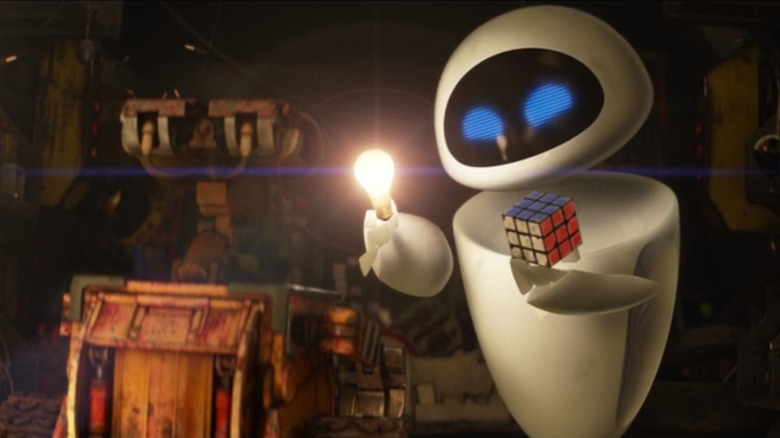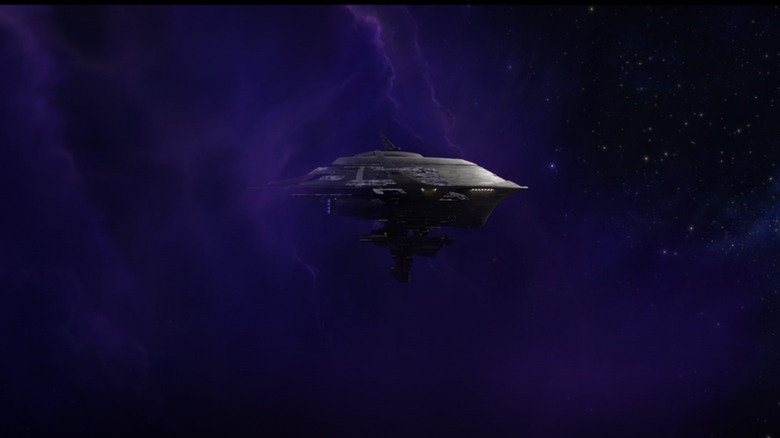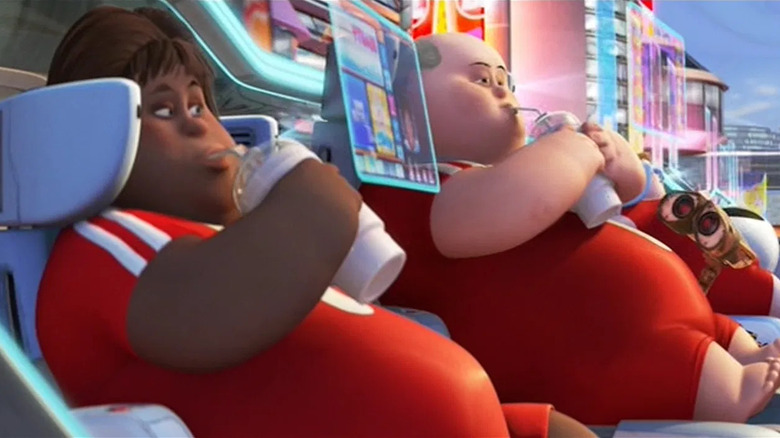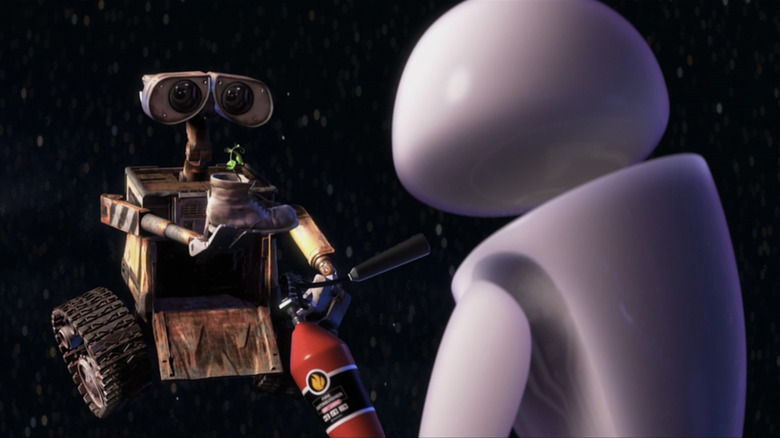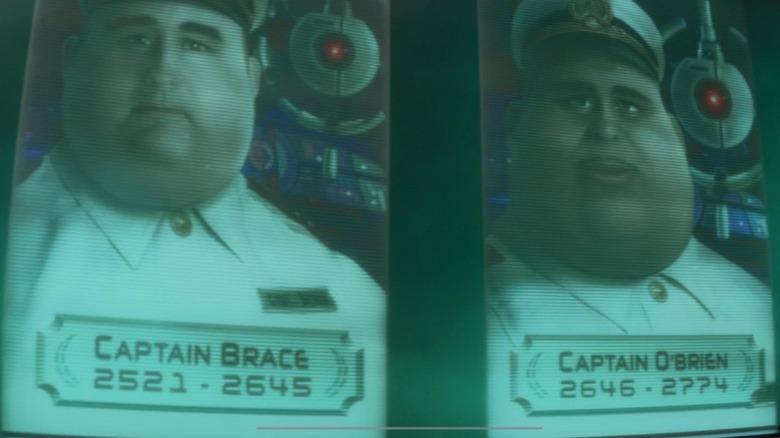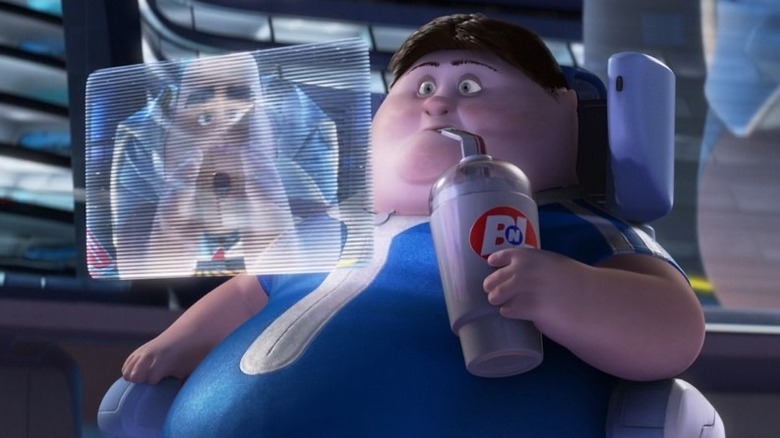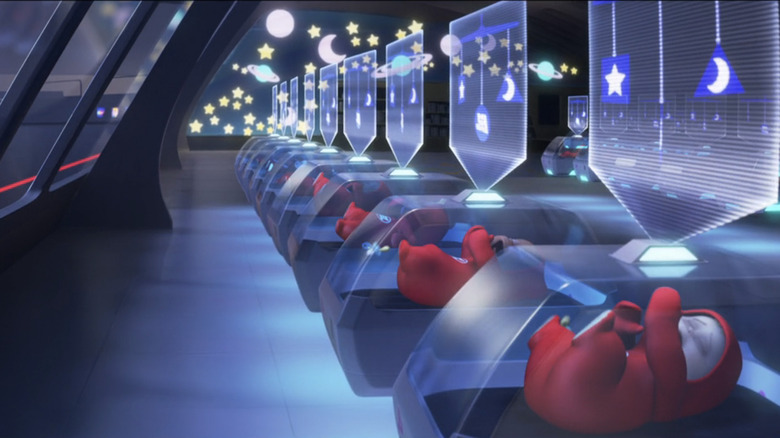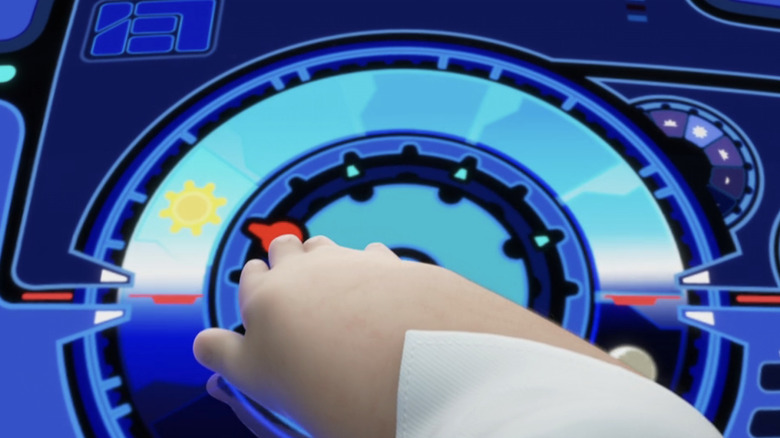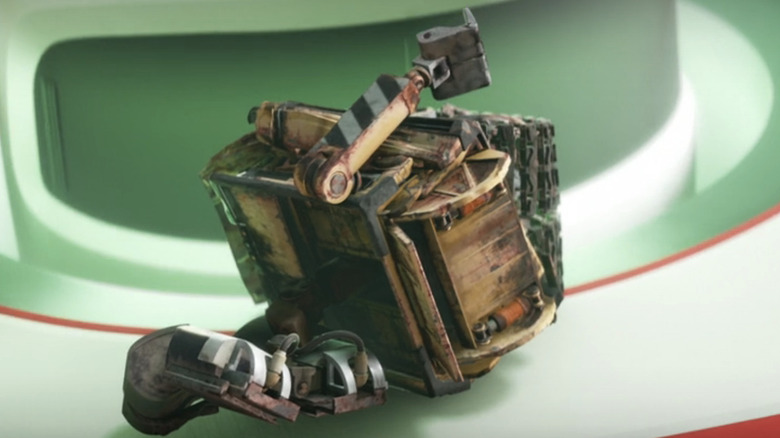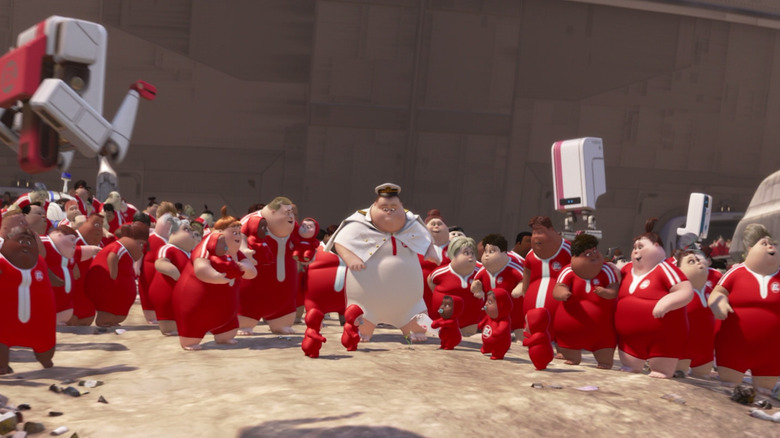Wall-E Moments That Go Right Over Kids' Heads
On the surface, "Wall-E" is a heart-warming adventure about an earnest robot that saves humanity and finds love along the way. The 2008 film is one of the best Pixar films ever made, worthy of its entry into the vaunted Criterion Collection. It offers simple entertainment for the kids and something meatier for adults, in true Pixar fashion. Unlike most films from the studio, "Wall-E" doesn't have much in the way of double entendres. Granted, it's hard to do that when the robots and the humans are almost indistinguishable from one another. Instead, it is the questions raised by the story itself that merits adult consideration.
"Wall-E" openly tackles themes such as conservation and identity. Kids would need to be strapped to the film's hover chairs not to notice these overarching messages, but there are many deeper themes they just won't notice. Innocence has its privileges. Fair warning: "Wall-E" is a colorful animated film, but underneath that veneer, it gets dark in a hurry. You have been warned. Here are the "Wall-E" moments that go right over kids' heads.
Wall-E is a post-apocalyptic story
The opening of the film reveals a completely decimated planet, a place of death and ruin. Wall-E is the only bit of movement in all that rusty stillness, the lone survivor at the end of days. The robot scratches out an existence the only way it knows how, the same way we've seen in films such as "I am Legend" or "The Road": it combs through society's wreckage and takes what it needs.
First, he gathers the essentials. When Wall-E's treads start showing too much wear, it ventures into the shadows of an overpass that serves as a Wall-E graveyard and strips parts from the body of another robot. Later we find out it has dozens of spare parts stashed in its' hideout. It is not clear what happened to those other robots, or how Wall-E came to be the last. Perhaps Wall-E robots are like the immortals from "Highlander": there can be only one. Self-awareness and self-preservation go hand-in-hand. Perhaps some quirk of fate bestowed consciousness onto Wall-E in order to see its robotic kin as convenient ways to extend its own life. Granted, such a pessimistic outlook doesn't really fit with the Wall-E we know from the film, but several hundred years alone might've given Wall-E a sudden appreciation for life. If you think that's dark, we're only just getting started!
Buy n Large is a dystopian cyberpunk mega-corp
Most of the world-building in "Wall-E" is done via quick camera pans, jokes, and offhand references. In the introductory scene, we glimpse the "Earth that was" from the detritus left behind. A company called Buy n Large literally ran everything: supermarkets, gas stations, banks, and transportation. They controlled the news and printed the currency. It's not a stretch to suggest they ran the world. Shelby Forthright (Fred Willard), President of Buy n Large, directed the evacuation and clean-up efforts and issued decrees from a podium that closely resembled the ones used by U.S. Presidents.
The problem with such an arrangement is that most capitalistic companies are only beholden to their bottom line, and things like conservation or "the greater good" is not part of the equation. Buy n Large pursued an agenda of consumption for consumption's own sake, which buried the planet in garbage and left it an unlivable toxic wasteland. Buy n Large then built starliners to ferry everyone off-planet, which might be taken as a selfless action if not for how the company continued to distract everyone from what was really happening.
9-to-5 drudgery
The film's second sequence shows a day in the life of our plucky hero. Wall-E drags itself out of bed, slowly puts on its treads, and packs its cooler. It opens the door and stands in quiet contemplation of the work ahead before sighing heavily and trudging out the door. Wall-E's job is to collect and stack Earth's garbage, one cube at a time. The robot has been doing this for over 700 years. Some of the stacks rival skyscrapers ... and you thought your job was bad.
The work is tedious, boring, and without end. Wall-E copes with the soul-killing drudgery by looking for interesting things amid the trash. The world is a dumpster and Wall-E is the last dumpster diver. It finds plenty of distractions along the way, including a woman's bra that it tries on over its optical sensors because that is the most sensible place to wear it. In addition to being funny, this goes a long way toward humanizing Wall-E. We all waste time on silly things at work.
Wall-E shouldn't be self-aware
Most of the robots we meet in "Wall-E" have personalities of a kind. How and why is not really explored, though we can assume it has to do with 700 years of computer advances. What is clear is that the Wall-E trash collectors left behind on Earth were not self-aware when they started cleaning up the garbage. This becomes obvious when Eve swaps out Wall-E's motherboard, essentially reverting it back to factory settings. Newly blank, Wall-E doesn't recognize Eve. Its only concern is for the directive: clean up all this garbage.
Somehow life sparked within Wall-E's rusty innards, developing into a personality. We see him humming and dancing. He cares about a cockroach and is alarmed when it accidentally runs over the bug. The robot experiences hope, sadness, and depression. It clearly yearns for real companionship, as noted from the way Wall-E watches the old musical "Hello Dolly!" We don't see how this miracle of evolution happens, but one thing is for sure: the plant wasn't the only life found on Earth.
Where are the other ships?
After Eve locates the plant specimen and is retrieved from Earth, Wall-E hitchhikes on the trip across space. Axiom, an enormous starliner built by Buy n Large, is parked in a purple cloud formation at the edge of the solar system. We know the Axiom is "the jewel of the BNL fleet" from an advertisement Wall-E accidentally triggers in the intro. Where then is the rest of the fleet? There have to be other ships ... right?
We never see the rest of the fleet and there is no reference to other ships. Captain McCrea (Jeff Garlin) makes no attempt to contact any other captains after he learns that life has returned to Earth. The Axiom and its complement of passengers may be the only humans left alive. Those other ships were either lost, destroyed, or never left Earth at all. There is at least one tiny clue to support the theory that Axiom is the only ship that made it into space: Early in the film, Wall-E rolls past a bank where money litters the ground, thousands and thousands of dollars now worthless. It conjures images of a crowd rioting because they are unable to escape the doomed planet. This is all conjecture, but Wall-E is a dark film when you stop to think about it.
The technology trap
Much has been made in recent years about the ubiquity of screens and the negative effect they have on our lives. "Wall-E" takes this concept to an extreme as the passengers aboard the Axiom are never without a screen to look at. They zoom around the starship on hover chairs, a holo screen blocking their view of the world at large. When Wall-E inadvertently breaks two passengers out of their tech-coma, both are surprised to discover the ship has a pool.
All satire is a bit far-fetched, but in stretching to get a laugh "Wall-E" quietly comments on how often we serve technology instead of the other way around. Captain McCrea is purportedly in charge but is undercut and overruled by Auto, the ship's AI, at every turn. When McCrea finally decides not to acquiesce to Auto's demands, the AI locks the captain in his chambers. Only with this mutiny does McCrea recognize how much control he has handed over to the AI. This awakening mirrors what slowly happens across the Axiom as the passengers awake to how much of life they've been missing out on.
The vacuum of space kills life
As part of its efforts to follow directive A113 (i.e. keep the humans away from Earth), Auto has a security robot put the plant in an escape pod and jettison it into space. Wall-E ends up in the escape pod too. Hijinks ensue, resulting in the escape pod detonating. Wall-E survives, somehow, then uses a fire extinguisher as a propellent to fly through space.
Wall-E reunites with Eve in the depths of space. Distraught Eve can't follow its directive without the plant, but Wall-E managed to stash it in its compression compartment. Wall-E opens the compartment and brandishes the plant, voila. Again, in the black depths of space, where all life dies. That should've been the end of the adventure right there, but (impossibly) the plant doesn't wilt. There are a lot of questionable things, science-wise, but this is without a doubt the most egregious.
The absurdly long lifespans
Shortly after Wall-E arrives on the Axiom, we get a glimpse of Captain McCrea's personal quarters. Holograms of previous captains are projected on the wall. As the camera pans by, the obvious thing to note is just how much fatter each successive captain has gotten. However, the observant viewer learns an interesting tidbit that otherwise goes unnoted. The Axiom captains are all very long-lived. Their average years of service are 131 years, and that's just time served!
We can safely assume they didn't become captains until they were at least 18 years old. All but one of the captains likely retired instead of dying on the job, which we know because the service years don't overlap except in one case. All told, the average life expectancy is closer to 200 years than 100, which is especially mind-boggling when you consider their completely sedentary lifestyle. Just what is in those shakes, anyway?
Regenerative food buffet
Since we're on the subject, let's talk about those shakes. After Captain McCrea takes his position on the Axiom's bridge, the computer runs through status updates on all of the ship's major systems. Amid the sorts of stuff you'd expect — mechanical systems, reactor core, life support — there is one update that stands out because it is so wildly different: Regenerative food buffet. What?!
This sneeze-and-miss-it reference is the only time we hear those three words. Food is plentiful on the ship. Nearly every time we see a human, they're slurping down a Big Gulp, but we never get any other references to what exactly these people are eating. "Regenerative" suggests a sort of cloning since, in all likelihood, animal life on Earth went extinct or was left behind to die out. We never see any evidence to the contrary. So they probably aren't drinking ground beef. Perhaps there is a lab on the ship where steaks are brewed in Petri dishes and blended into smoothies. It's feasible, but there is one other possibility.
Where do babies come from?
One of the ongoing subplots in "Wall-E" is how detached from reality humankind has become. We've been fattened up and pampered by Buy n Large's army of robots and have lost touch with our very humanity. There is a moment midway into the film when Mary (Kathy Najimy) and John (John Ratzenberger) briefly and accidentally touch hands. Both are surprised and elated by the sensation, which makes it pretty clear the humans aren't doing anything more intimate aboard the ship.
Later, we see a nursery full of sleeping babies. Umm ... what? It would seem as part of its "save humanity" business plan, Buy n Large has been cloning or otherwise growing humans in vats someplace. There is no other possible explanation. To further underscore that point, the babies pop up again when Mary and John save them from injury and possibly worse, becoming surrogate parents. Nobody else claims the babies because they don't belong to anyone. Robots growing humans and distracting us from what's going on has strong "The Matrix" vibes, but if you want to really turn the screws, consider again: what is in those shakes?
Time is an illusion
The great Albert Einstein once said: "People like us who believe in physics know that the distinction between past, present, and future is only a stubbornly persistent illusion." In other words: Time itself is an illusion. Though it's clear where Einstein came down on the issue, the debate still rages today among scientists. You wouldn't expect a movie meant for kids to weigh in on the subject, but while "Wall-E" stays above the fray, it includes a winking reference.
After Captain McCrea gets his morning status updates from the ship's computer, he is alarmed to discover it's already 12:30. He missed giving the morning announcements, which is the highlight of his otherwise boring day. It's a problem McCrea solves for himself as he turns a time dial back three hours, to 9:30. This causes the artificial sun to change position in the sky and the lunch slurries to swap out for breakfast slushies. Those are the only material changes. Otherwise, life continues on as it was, as though time itself doesn't actually matter.
Wall-E should have died
Toward the end of the film, Wall-E heroically stands up to Auto and protects the plant. For such insolence, Auto fries Wall-E with enough electricity to melt holes in its motherboard. Wall-E spends the rest of the movie on death's door, before finally succumbing after getting crushed while holding open the holo detector's door.
After arriving on Earth, Eve hurriedly swaps out Wall-E's broken bits for new ones, including a hole-less motherboard, and leaves him charging in the sun. Wall-E powers on, only it's not Wall-E anymore. As we touched on already, this Wall-E has forgotten all about Eve and dancing. All those memories were stored on the destroyed memory chips. So too, was Wall-E's endearing personality. It is dead and nothing can bring it back now. Holding hands certainly wouldn't do it, but for movie magic. Chalk this one up to "wishful thinking" and "this is Disney, we need a happy ending."
The Earth is humanity's responsibility
The story doesn't directly answer the obvious question of "How did the world go so bad?" It's something we want to know, mostly due to our idle but ever-present self-preservation instincts. Yet the question isn't relevant to the story, in much the same way that "Mad Max: Fury Road" never clarifies who killed the world. It doesn't need to, since the answer is obvious: we did.
Humanity's consumption ruined the Earth, literally burying it in the trash. It's a clear metaphor for climate change and our role in the ongoing destruction of our homes, but it's a problem that will only be solved when humanity rolls up its sleeves and does the hard work. After viewing Eve's recordings from Earth, Captain McCrea is initially disappointed. There's no blue sky or green grass. It's all just brown and dead. McCrea waters the plant, remarking that it "just needed someone to look after you." At that moment, he comes to a striking realization. Humanity needs to look after the Earth. It's not something we can delegate to Buy n Large's robots. The Earth is our home, and we are responsible for taking care of it.
